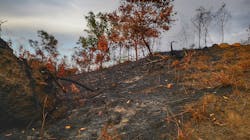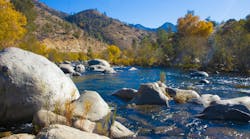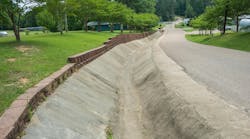Post-wildfire mudslides, floods not caused by water-repellant soil
New research disproves the belief that burnt watersheds create a water-repellant layer, causing more mudslides and floods after wildfires. Instead, burnt watersheds may hold more water in their soil due to lack of vegetation, according to a press release from the University of Southern California (USC).
Common knowledge has long held that loss of vegetation during a fire leaves soil vulnerable to erosion because the plant roots that hold the soil in place wither and die. Some people have held a different view that, as leaves burn, their waxy coating forms an organic, oily substance on the soil’s surface.
This waxy coating creates a water-repellant layer at or near the surface. Some professionals believed this layer prevented the ground from absorbing water, resulting in rapid water runoff that carries mud and debris.
New research published in Nature Communications has called that theory into question.
Scientists at the USC Dornsife College of Letters, Arts and Science, in collaboration with researchers from the University of Michigan, the U.S. Geological Survey and Rutgers University, monitored two wet seasons following the Bobcat Fire, from December 2020 to March 2022. The team concluded that water was, in fact, being absorbed by the burnt ground that contained this waxy coating.
Specifically, the team studied three watersheds in Southern California’s San Gabriel Mountains. Two of the watersheds burned during the 2020 Bobcat Fire and the other was mainly untouched.
The researchers found that post-wildfire, a significant portion of the water flow in all three watersheds came from water that had been absorbed in the ground.
Joshua West, professor of Earth sciences who led the study at USC Dornsife, said it was no surprise that the flow of water and debris in the burned area’s stream was four to 10 times greater than the flow in the unburnt area’s stream. What he didn’t expect was that stormwater had permeated the ground in both of the burnt watersheds.
This finding contradicted previous beliefs that little water would be absorbed in the burnt watershed due to the presence of waxy soils.
In the unburnt watershed, however, the researchers found that trees absorbed the water as anticipated, preventing it from reaching streams.
West and PhD candidate Abra Atwood surmised that, in keeping with the popular notion, increased water in rivers originated from the burnt areas because burned trees and vegetation could not retain water in their roots as they normally would, but not from the inability of the soil to absorb water.
The research team’s finding that the water-repellant layer does not prevent water from being absorbed into the soil strengthened their hypothesis that the water in streams comes from both rainfall and groundwater, leading to increased flooding in burnt areas versus unburnt.


